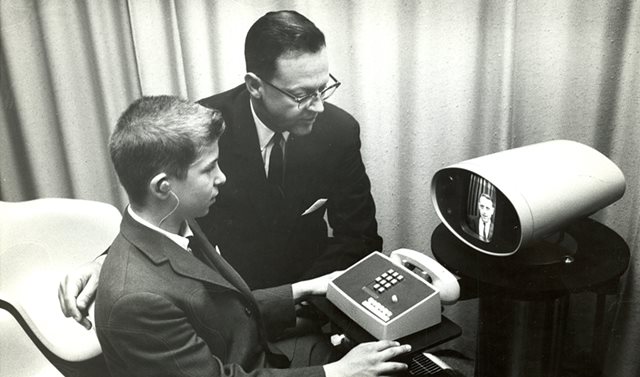With the globalization of teams and conference rooms expanding to include video capabilities, video conferencing isn’t just another trend that’s going to fade away anytime soon. The history of video conferencing let’s us have a better understanding of where the technology started from to how we use the technology today, giving us a better perspective on something that is becoming a crucial part to organizational collaboration.
Video, a clunky start to something big
In 1968, video conferencing was first introduced and packaged as a commercial solution at the World’s Fair in New York. The technology introduced was called the Picturephone from AT&T. Participants were able to sit down and communicate “via video” with the person on the other end for 10 minutes at a time to experience the first video telephone device designed for the masses. Unfortunately, this particular machine was ridiculously expensive, clunky and difficult to set up, so it didn’t exactly take off. Still, being able to see someone that was long distance from the comfort of your couch was pretty cool for the 1960s.
With the clunky start, video adoption didn’t have a chance to go mainstream until the 1980’s. Video remained a sci-fi fantasy in the minds of consumers because it seemed implausible that is until the introduction of systems from Compression Labs. These systems began to sell for $250,000 and the video conferencing system from PictureTel took a big price drop to $80,000 in the late 1980s making both seem much more attainable to larger corporations.
In the 90’s major advancements in IP technology, the internet and video compression enabled more possibilities for video collaboration via desktop. IBM took notice and dropped the price of their systems to $20,000 systems, while the introduction of CU-See Me (no audio) from Macintosh made video collaboration a bit more of a reality for consumers and businesses alike.
The late 1990s to early 2000’s, Polycom played a large role in the evolution of video conferencing with systems such as the ViewStation® in ’98 that put Polycom at 1 billion in sales for the year and their desktop solution, Via Video which debuted in 2000.
Scale of video adoption and usage
Although enterprise adoption was continuing to grow, the mid-2000’s was a crucial time for video conferencing use cases outside of enterprises. Courts, law firms and military needs for video conferencing came into play, more specifically – video conferencing kiosks, and mobile technology for collaboration across borders. However, the biggest use cases driving video adoption at the time were higher education distance learning and telehealth in healthcare.
In 2003, major advancements in telehealth, like the first transatlantic “telesurgery” helped drive more awareness of the impact and possibilities of video technology in healthcare. Video technology allowed a surgeon in the U.S. to control a robot overseas to perform a successful gall bladder surgery.
Enterprise video adoption
Where video really began to take off was throughout large global enterprises who realized the need to reduce travel, increase product time to market and improve collaboration. Wifi and HD video camera technology in smart phones and laptop devices helped push video out of “the boardroom” for many large enterprises, and into the hands of knowledgeable workers across the organization.
Video adoption gains traction
In a Wainhouse report from this year, IT decision makers reported using video in 45% of their meetings. The more video utilization across the organization, the more efficient and cohesive communication becomes inside and out. Video collaboration helps keep meeting participants more engaged throughout the meeting, and drive better outcomes than audio. At Vyopta, using video builds better relationships with our customers through face-to-face interaction and adds a bit more of a personal touch to our one-on-one meetings.
Analytics for enterprise video environments
As video administrators deploy company-wide technologies including mobile and desktop solutions – the environment simultaneously becomes more difficult to manage without analytics. Issue resolution for video infrastructure and quality across the large video conferencing environment is nearly impossible without a real-time monitoring solution.Many video IT teams use real-time quality monitoring tools for complex, multi-vendor video environments to improve their networks in-house, rather than outsourcing.
Video conferencing has come a long way. Things have changed a lot since the 1968 World’s Fair. Now, organizations are seeking way to adopt analytics like Vyopta that manage unified communications networks. Using an analytics solution gives companies the empowerment to access video collaboration and it’s seems like it’s becoming a very fluid, natural progression into becoming more mainstream.
Learn more about how Vyopta is helping companies manage their video conferencing networks. Try our online demo today!






